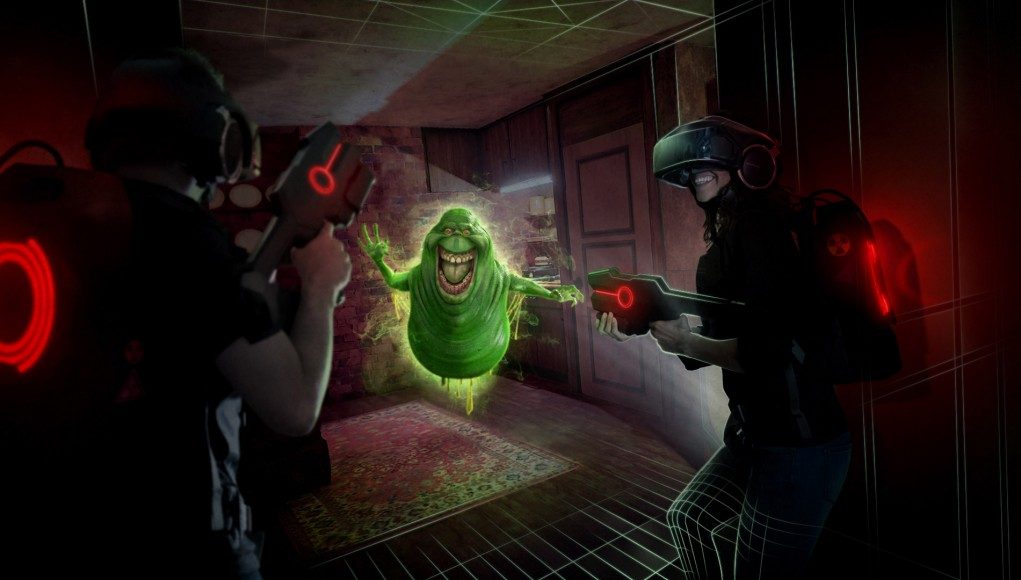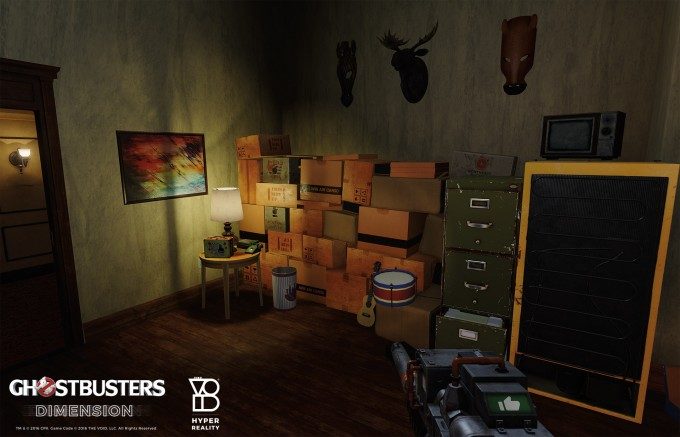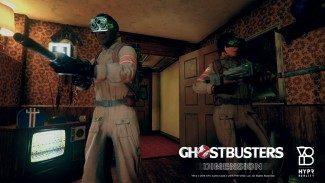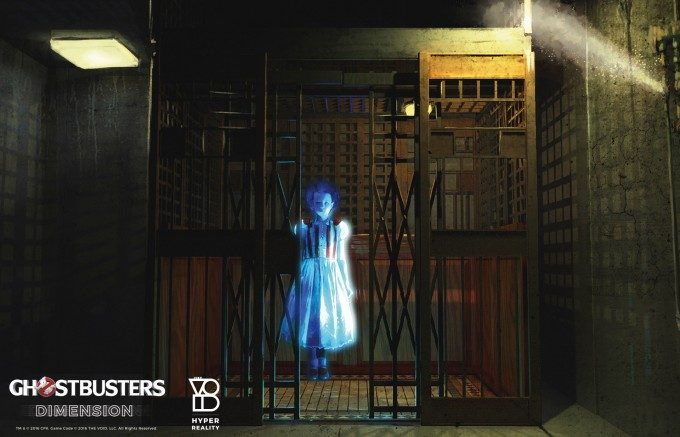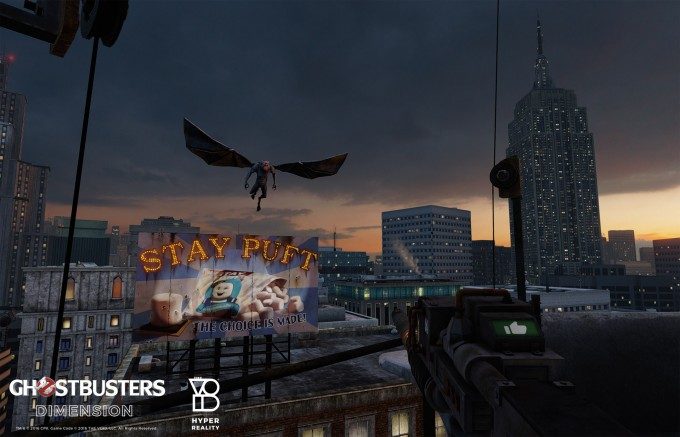Standing in the lobby for thirty minutes, watching the crowd lumber by in the distinctive mode of Times Square tourists, overlain with the Ghostbusters theme (endlessly looped), I thought, without any special vigor, about where I was, and why I was there. I wondered: what justification does The VOID have for coining the term ‘hyper-reality’, and why has their platform been deployed in Madame Tussaud’s, a venue known for it’s life-like wax replicas of celebrities?
Suiting Up
 An attendant instructed me to wait in line next to two CNET video correspondents, with whom I later shared the Ghostbusters: Dimension experience. We waited some fifteen or twenty minutes for the groups before us to finish. The ‘ride’s’ capacity is two teams of three, with entry staggered so that the teams never meet.
An attendant instructed me to wait in line next to two CNET video correspondents, with whom I later shared the Ghostbusters: Dimension experience. We waited some fifteen or twenty minutes for the groups before us to finish. The ‘ride’s’ capacity is two teams of three, with entry staggered so that the teams never meet.
I entered a small, barracks-like atrium and donned, with the help of an attendant, first a haptic vest, then a headset, and lastly received my weapon. The vest buckles and tightens to comfort, while a knob at the back of the VR headset screws to fasten and loosen. Important to the headsets functioning is the user’s ability to push the viewer up to allow one to quickly see their actual reality. Visors in place, CNET 1 & 2 and I walked to a square defined by a broad yellow line and lowered our viewers. Cue Ghostbusters.
Inside Ghostbusters: Dimension
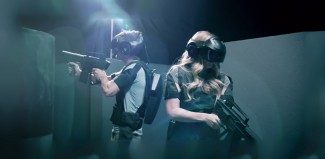
My teammates and I took the form of three Ghostbusters cadets, nearly identical white males garbed in the expected attire and toting proton packs. Initially, my comrades’ weapons warped and jumped around and through their avatars, limiting (but conversely also enabling) my immersion in the scene by providing something to look at as we waited for a bulb to light above a door, thereby ushering us forward unto virtual ghosts.
When I said that we were ushered forward, I mean it; the experience is navigated by physically walking around what amounts to a real stage that is overlaid with the virtual world.
The experience’s graphics are not cutting edge; when it began, I did not find myself far on the ‘fake’ side of the Uncanny Valley. The graphics don’t need to be cutting edge, though. As the experience continues, and as my temporal distance from my usual reality lengthened, I ceased noticing, or at least ceased considering as a negative, the graphical disparity. They, the graphics, had become the reality most immediately demanding my attention.
There are splinters of narrative scattered throughout the experience that together do not approximate, or attempt to approximate, really, a coherent story. They don’t need to. The work that Ghostbusters: Dimension does to absorb players in its scenario is not, after all, primarily or even secondarily narrative. It is sensory and ontological. There are ghosts of pets which may owe their existence to a psychopathic girl who lived in the building, which, once grown, may have murdered her housekeepers, but then hither is the Stay Puft Marshmallow Man, and then thither are gargoyle-like demons, and we, the performers, are playing callow cadets on our first mission.
In reality, the weapon I’m holding is a The VOID’s Nova Mk IV Gun; it’s light easy to aim, and features a trigger, a pump-action reload mechanism (not used in Dimension), and what appears to be a second trigger beneath the primary one (also not used in this experience). During Dimension, the Nova becomes a ‘Proton Pack’, and in this form it’s incredibly easy to use: players can accurately blast ghosts from the hip with rather girthy energy beams. In other words, there’s not a lot of aiming involved. Which is an early indicator that the combat is not difficult.
You’re going to blast some virtual ghosts, and they’re going to disappear. That’s that. There’s no reloading, there’s no way to take damage—there are no player-incurred penalties, in other words. It is, after all, a ‘ride’ more than game.
I don’t think that there is any way to ‘lose’ the experience, actually, as that would really gum up the timing of the whole thing; players must make their way through the course quickly enough to keep a regular stream of teams coming through.
I would be very interested to learn what happens if one objects to participating and either stands around (and doesn’t move forward) or doesn’t blast the ghosts as intended. Alas, I did not rebel; even if I had, my CNET comrades would have pushed onward. Although we couldn’t lose the game, I did feel as though there were stakes, and as though I had to act, because of how ultimately engrossing the experience was: it was my primary visual reality, and virtual ghouls were attacking me.
While the headset is large, no component weighed enough to distract me from my virtual surroundings, which in the first case consisted of an old hotel room that quickly became populated by a host of relatively benign pink ghosts. A prerecorded voice in my headset’s earphones indicated they (the virtual-soccer-ball-sized pink ghosts) likely ascended from dead pets. It was our task to blast the cutesy pink orbs-with-eyes, and to keep blasting them into what one assumes is a final oblivion.
We next proceeded down a hallway and into an elevator, which climbed until stopped by Slimer, who charged through the elevator’s gates, through our avatars and through the opposite wall, cueing a real scented mist to spray our real bodies. This is, after all, a ‘4-D’, ‘hyper-reality’ experience. A semi-translucent, blue ghost of a maybe-5-year-old girl next approached the elevator, hovered for us to observe, and then dissipated.
During our next bout of combat, we blew a hole in an external-facing wall and stepped out into further combat atop a rather rickety-seeming scaffolding. Through the headset we appeared to be hundreds of feet above ground and, alarmingly, the scaffolding shook beneath our feet. Gargoyles flew around us forming a spectral New York skyline, replete with swarming spirits and a great green light beam streaming into the sky from atop a tower’s spire.
I was taken aback by the final gargoyle-creature clasping the scaffolding’s rail nearest my avatar and making a fuss in my face before disintegrating under our proton packs’ fire. The scale of the scene, too, and the doublethink immersion I experienced (“The scaffolding is shaking! …There is no scaffolding”) kept my attention.
Our final encounter, and the last leg of the experience, involved a trashed penthouse haunted by a tall, blue female ghost who casts all manner of ground-plucked debris at our avatars, causing me more than once to wince and turn my head for fear of being hit. When finally thoroughly zapped, the blue ghost gave way to the Stay Puft Marshmallow Man, who swiftly demolished half the room and whose weakness remains, after so many years, crossed proton pack beams.
And that was it. We were discharged, expressed our gratitude and positive reactions, and left, passing waxy recreations of Presidents Kennedy, Reagan, Nixon and Clinton, Maya Angelou, Einstein, Hemingway, Gandhi, multiple Pontiffs, and actors galore—the usual stuff of Madam Tussauds.

